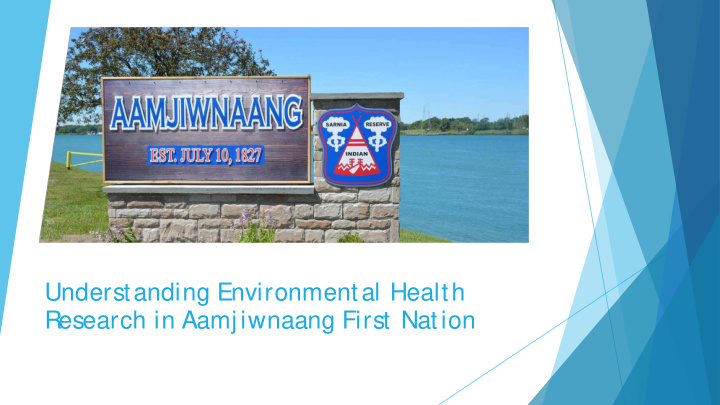



Understanding Environmental Health R esearch in Aamj iwnaang First Nation
Aamjiwnaang is located in the heart of the Chemical V alley, one of Canada’s largest concentrations of industry
u Air quality, water quality and the presence of contaminating chemicals have been a longstanding concern for our community u Community members rank environmental concerns as one of the biggest challenges facing our community u Attempting to address concerns about our health and the environment, we have participated in several research studies over the last 20 years
In the Media
“ The situation in Aamj iwnaang offers a clear picture of discrimination, since Indigenous homes and kindergartens are a stone's throw away from large petrochemical refineries.” (Unit ed Nat ions S pecial Rapport eur on Human Right s and Toxic S ubst ances 2019) “ The people of Aamj iwnaang have suffered immensely from the shadow of Chemical Valley, and they continue to do so... Industry and the MOECC should do everything practicable to achieve improvements...the longer this takes, the longer the people of Aamj iwnaang will be exposed to pollutants known to adversely affect human health.” (Environment al Healt h Commissioner of Ont ario 2017)
Research Overview S ome Key Findings
Body Mapping Proj ect (2005) u Community members self reported health information u R esults suggest that residents may experience higher incidence of miscarriage, asthma, learning problems and rashes
S ex Ratio S tudy (2005) Found that the proportion of male live births showed a statistically significant decline over a 10-year period during 1994-2003.
Food Consumption S tudy (2005) Found that chemical levels in fish from a local pond, wild game and pond sediment were very low and do not likely pose a significant risk to the First Nation
Biomarkers of Chemical Exposure (2013) u Mother and child pairs provided biological samples to test for a variety of pollutants u Findings suggest that mothers and children on the First Nation are exposed to a number of environmental pollutants, and that exposure may be higher than the average for some chemicals, including: cadmium, mercury and some PCBs
Community Cancer Profile (2013) u A community cancer profile developed in partnership with Cancer Care Ontario showed the number of cancer diagnoses was not significantly higher than expected u Actual number of diagnoses was higher than expected, which demonstrated challenges with small population size, lack of appropriate comparison data
First Nations Food, Nutrition and Environment S tudy (2013) u Mercury levels in hair decreased compared to previous studies u Levels of contaminants tested in foods were low u Metal levels in tap water were low u CHALLENGE – difficult for community to accept findings that do not align with their beliefs
S creening Level Risk Assessment from R ecreational Use of Talfourd Creek (2014) u Talfourd Creek became a symbol of toxicity in the early 2000’s when unsafe levels of chemicals were detected u In 2014 a screening level risk assessment suggested that adverse health effects are not likely to occur from contact with sediment and water from recreational use of Talfourd Creek
T ap Water S ampling (2017-present) T ap water samples testing for more than 100 compounds & pollutants are below the maximum acceptable concentrations
Current Projects
u Updated S ex Ratio S tudy (Dr. Laurie Chan) u Compilation of all previous studies with recommendations on moving forward (Cancer Care Ontario) u Cancer risk assessment from air exposures (CAREX Canada) u S arnia Area Environmental Health Initiative (Ministry of Environment, Conservation and Parks) o What are we being exposed to and what are the health risks? o How are we impacted by noise, light, vibration and odour? o Garden study
Recommend
More recommend